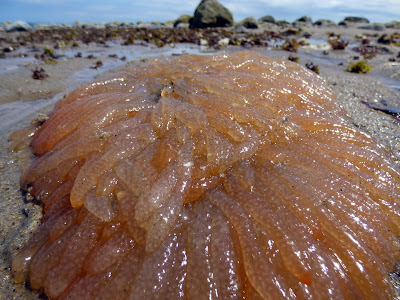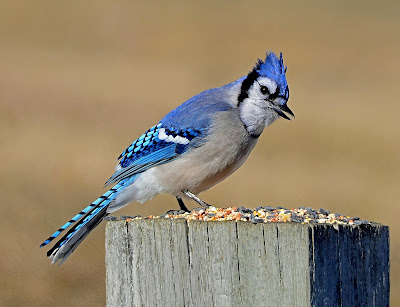NATURE NEWS
Has this sea jelly made you nervous about swimming?.... Fear not!
published August 13 2016 in the York Weekly/Portsmouth Herald/Foster's Daily Democrat
 |
| Atlantic longfin squid egg mass-n as an egg mop. Photo by Sue Pike |
I was out on the beach at Plum Island a week ago and found a weird jelly-mass washed up in the sand. At first glance squid eggs came to mind, but that seemed somehow far-fetched, so my beach-combing friend and I decided it was a dead jellyfish. This thing was huge — over a foot in diameter, and did look like some sort of upside down jellyfish with short, fat tentacles. We were worried about getting stung so, unfortunately, didn’t prod it or try to turn it over. I snapped some close-ups of its “tentacles” and we left it. It bugged me though. I wanted to know what it was, so I looked through photos of possible jellyfish found in the Gulf of Maine. I couldn’t find a likely candidate so broadened my search to include squid eggs and found a match. This killed me — we could have picked it up, we could have tried to save the little squidlets, we could have tried to look at the little squid eggs under a microscope.
One of the many lessons I learned from this encounter (always go with your gut feeling, never just leave something) was that I had no idea whether squid even lived in the Gulf of Maine. So, I contacted the Darling Marine Center in Boothbay Harbor to ask the experts.
I sent a photo of the jelly mass to Joe Thompson, a researcher from Franklin and Marshall College in Pennsylvania who spends summers studying squid muscle physiology and swimming biomechanics at the Darling Marine Center. He confirmed that the mass I found on the beach belonged to the Atlantic longfin squid (Doryteuthis-formerly Loligo-pealeii) - the most common squid in nearshore waters in New England. According to Joe this squid can grow to a whopping 20 inches but are more commonly about a foot long. “Each of the finger-sized egg cases is deposited by a female and contains between 50 and 150 embryos. A female will typically lay many dozens of the egg fingers during the breeding season, after which she will die. The mass of egg fingers is called an "egg mop" and multiple females can contribute egg fingers to a single mop. The ends of the egg fingers are sticky initially, and the females usually adhere the ends to a hard surface (e.g., rocks, dock pilings, etc.) in relatively shallow (often less than 40 feet). If the water temperature is in the mid to high 60s, the embryos will develop and hatch in about two weeks.”
Longfin squid are harvested commercially as calamari-and while we (and many other species) eat them, according to Joe they, in turn, are “ravenous carnivores throughout their lives, eating larval fish and planktonic crustaceans soon after the squid emerge from their egg cases, and then switching to a diet mainly of fish and other cephalopods as they grow.”
Squid are one more thing to watch for off our shores - I was just telling a fisher friend about this egg mass and he told me about how to catch them with lures composed of diamond shaped barbs instead of hooks, of watching masses of these creatures swarming in the water. How squid are the fastest known marine invertebrates – propelling themselves through the water using jet propulsion.
If you want to try to see some squid follow the example of the researchers - Joe told me about nights spent on lighted piers and docks fishing for squid with flashlights. One night a harbor seal rocketed through a group of squid - the squid jetted away in all directions - six of them leapt up onto the dock and into the nets of the researchers.
Shining a powerful flashlight into the dark coastal waters at night is magic-you’ll attract myriad ocean critters - tiny copepods and shrimp, little fish will dart in and out of the beam, jelly fish and comb jellies will pulsate in the light, and if you’re lucky a squid might dart by.



Comments
Post a Comment